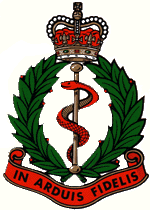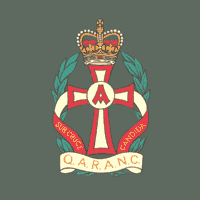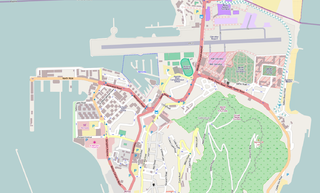
RFA Argus is a ship of the Royal Fleet Auxiliary operated by the Ministry of Defence under the Blue Ensign. Italian-built, Argus was formerly the container ship MVContender Bezant. The ship was requisitioned in 1982 for service in the Falklands War and purchased outright in 1984 for a four-year conversion to an Aviation Training Ship, replacing RFA Engadine. In 1991, during the Gulf War, she was fitted with an extensive and fully functional hospital to assume the additional role of Primary Casualty Receiving Ship. In 2009, the PCRS role became the ship's primary function. Argus is due to remain in service until 2024.

The Royal Gibraltar Regiment is the home defence unit, part of British Forces Gibraltar for the British overseas territory of Gibraltar. It was formed in 1958 from the Gibraltar Defence Force as an infantry unit, with an integrated artillery troop. The Regiment is included in the British Army as a defence engagement force. In 1999, the regiment was granted the Royal title. The Regiment recruits from Gibraltar, the United Kingdom, Republic of Ireland and the Commonwealth.

The Royal Army Medical Corps (RAMC) is a specialist corps in the British Army which provides medical services to all Army personnel and their families, in war and in peace. The RAMC, the Royal Army Veterinary Corps, the Royal Army Dental Corps and Queen Alexandra's Royal Army Nursing Corps form the Army Medical Services.

A military hospital is a hospital owned and operated by the armed forces. They are often reserved for the use of military personnel and their dependents, but in some countries are made available to civilians as well. They may or may not be located on a military base; many are not.

Queen Alexandra's Royal Army Nursing Corps is the nursing branch of the British Army and part of the Army Medical Services.

RFA Bedenham was a naval armament carrier of the British Royal Fleet Auxiliary that exploded while docked in Gibraltar on 27 April 1951, killing 13 people and causing a great deal of damage to the town.

Originally from the Atlas Mountains and the Rif Mountains of Morocco, the Barbary macaque population in Gibraltar is the only wild monkey population on the European continent. Although most Barbary monkey populations in Africa are experiencing decline due to hunting and deforestation, the Gibraltar population is increasing. Currently, some 300 animals in five troops occupy the Upper Rock area of the Gibraltar Nature Reserve, though they make occasional forays into the town. As they are a tailless species, they are also known locally as Barbary apes or rock apes, despite being classified as monkeys. The local people simply refer to them as monos when conversing in Spanish or Llanito.

A Royal Naval Hospital (RNH) was a hospital operated by the British Royal Navy for the care and treatment of sick and injured naval personnel. A network of these establishments were situated across the globe to suit British interests. They were part of the Royal Naval Medical Service.

The Royal Hospital Haslar in Gosport, Hampshire, was one of several hospitals serving the local area. It was converted into retirement flats between 2018 and 2020. The hospital itself is a Grade II listed building.

The military history of Gibraltar during World War II exemplifies Gibraltar's position as a British fortress since the early 18th century and as a vital factor in British military strategy, both as a foothold on the continent of Europe, and as a bastion of British sea power. During World War II, Gibraltar served a vital role in both the Atlantic Theatre and the Mediterranean Theatre, controlling virtually all naval traffic into and out of the Mediterranean Sea from the Atlantic Ocean.

Dame Doris Winifred Beale, was a British military nurse and nursing administrator who served as Matron-in-Chief of Queen Alexandra's Royal Naval Nursing Service from 1941 to 1944 during the Second World War. In the 1944 Birthday Honours she was appointed Dame Commander of the Order of the British Empire (DBE), a first in the Royal Naval Nursing Service.

Royal Naval Hospital Bighi also known as Bighi Hospital, was a major naval hospital located in the small town of Kalkara on the island of Malta. It was built on the site of the gardens of Palazzo Bichi, that was periodically known as Palazzo Salvatore. RNH Bighi served the eastern Mediterranean in the 19th and 20th centuries and, in conjunction with the RN Hospital at Mtarfa, contributed to the nursing and medical care of casualties whenever hostilities occurred in the Mediterranean. The building is now known as Villa Bighi and it houses a restoration unit.

Royal Naval Hospital was the Royal Navy's medical facility in the colony.

Surgeon Rear Admiral Lionel John Jarvis, CBE, KStJ, QHS, FRCR, DL is a British consultant radiologist. He was previously the Surgeon General of the Royal Navy and the Assistant Chief of the Defence Staff for Health. He served as the Royal Navy's Chief Medical Officer and Medical Director General (Naval) until April 2012. He was appointed as an Honorary Surgeon to the Queen (QHS) in 2006. He is currently the Prior of England and the Islands of the Most Venerable Order of the Hospital of Saint John of Jerusalem and is the Chair of St John Ambulance.

Profield Contractors, also referred to as Profield Contractors Ltd, is a Gibraltar-based construction company founded in 1989. The company has worked on a number of general construction and civil engineering projects in Gibraltar.

The Royal Gibraltar Yacht Club, formerly the Gibraltar Yacht Club, was established by officers of the Royal Navy in 1829. It was one of the first yacht clubs founded outside of Britain. British monarchs and Gibraltarian governors have been patrons of the club; the first visit by a reigning monarch was in 1954. During the latter twentieth century, the naval presence waned and the membership of locals dominated. The club's sailing school was established in 2001, accredited as a teaching facility in 2004, and became a testing centre in 2010. The reclamation projects in the middle section of Gibraltar Harbour necessitated the club's move from 26 Queensway to temporary premises. A new facility is under construction.

Streets in the British Overseas Territory of Gibraltar are represented by road signs as in the United Kingdom. As of 2007, Gibraltar has a network of 29 kilometres (18 mi) of roads.

Devil's Tower Road is a road in the British Overseas Territory of Gibraltar. The road, in the northeastern part of the settlement, runs south of Gibraltar International Airport, from Winston Churchill Avenue southeast to Eastern Beach Road. It was named after Devil's Tower, a seventeenth-century watchtower that was formerly at the eastern end of the road. By 2011, Devil's Tower Road had been changed to a dual carriageway, with on-street parking eliminated, and the Government's plan to change the name of the road to North Front Avenue met with community opposition. A new access road was planned, such that Winston Churchill Avenue, which crosses the runway, would no longer serve as the main road to the Gibraltar-Spain border. As of 2020 the project has yet to be completed.

The Princess Mary's Hospital, RAF Akrotiri,, was a military hospital located on the Royal Air Force base at Akrotiri on the island of Cyprus. The hospital was the last British military hospital to remain in operation after all other hospitals had closed down in the 1990s and 2000s. Originally the site was a dedicated RAF Hospital, but since 1996 it had been a Defence Medical Services asset. The hospital provided care for service personnel, their dependants and the local Cypriot population. It also treated many others from non-British and non-Cypriot countries. The setting of the hospital gave rise to the nickname Alcatraz, and it was staffed by personnel from the Royal Air Force and the British Army.






















